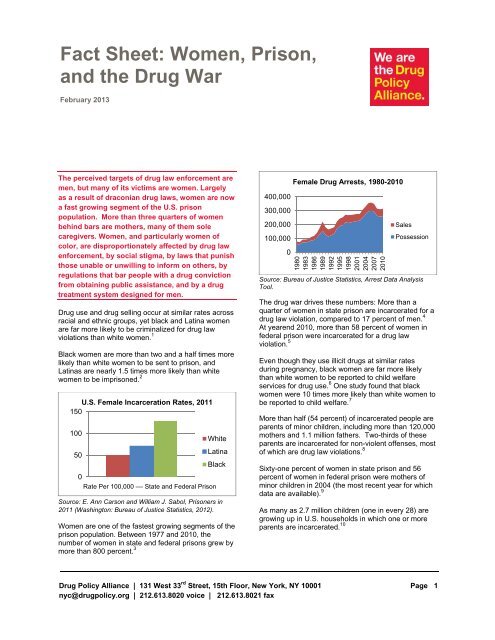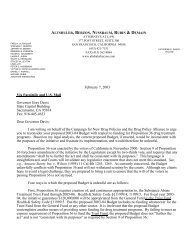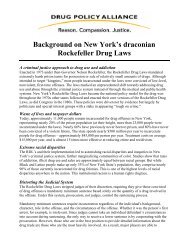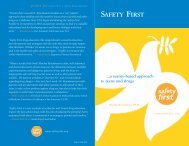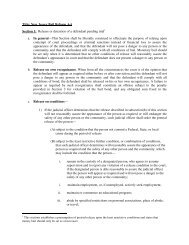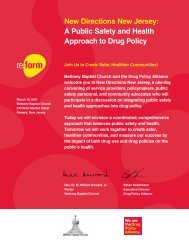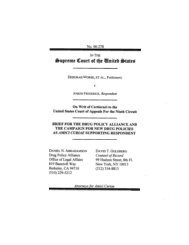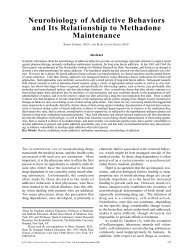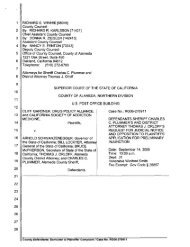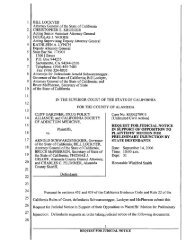Fact Sheet: Women, Prison, and the Drug War - Drug Policy Alliance
Fact Sheet: Women, Prison, and the Drug War - Drug Policy Alliance
Fact Sheet: Women, Prison, and the Drug War - Drug Policy Alliance
Create successful ePaper yourself
Turn your PDF publications into a flip-book with our unique Google optimized e-Paper software.
<strong>Fact</strong> <strong>Sheet</strong>: <strong>Women</strong>, <strong>Prison</strong>,<br />
<strong>and</strong> <strong>the</strong> <strong>Drug</strong> <strong>War</strong><br />
February 2013<br />
The perceived targets of drug law enforcement are<br />
men, but many of its victims are women. Largely<br />
as a result of draconian drug laws, women are now<br />
a fast growing segment of <strong>the</strong> U.S. prison<br />
population. More than three quarters of women<br />
behind bars are mo<strong>the</strong>rs, many of <strong>the</strong>m sole<br />
caregivers. <strong>Women</strong>, <strong>and</strong> particularly women of<br />
color, are disproportionately affected by drug law<br />
enforcement, by social stigma, by laws that punish<br />
those unable or unwilling to inform on o<strong>the</strong>rs, by<br />
regulations that bar people with a drug conviction<br />
from obtaining public assistance, <strong>and</strong> by a drug<br />
treatment system designed for men.<br />
<strong>Drug</strong> use <strong>and</strong> drug selling occur at similar rates across<br />
racial <strong>and</strong> ethnic groups, yet black <strong>and</strong> Latina women<br />
are far more likely to be criminalized for drug law<br />
violations than white women. 1<br />
Black women are more than two <strong>and</strong> a half times more<br />
likely than white women to be sent to prison, <strong>and</strong><br />
Latinas are nearly 1.5 times more likely than white<br />
women to be imprisoned. 2<br />
U.S. Female Incarceration Rates, 2011<br />
150<br />
100<br />
50<br />
White<br />
Latina<br />
Black<br />
0<br />
Rate Per 100,000 –– State <strong>and</strong> Federal <strong>Prison</strong><br />
Source: E. Ann Carson <strong>and</strong> William J. Sabol, <strong>Prison</strong>ers in<br />
2011 (Washington: Bureau of Justice Statistics, 2012).<br />
<strong>Women</strong> are one of <strong>the</strong> fastest growing segments of <strong>the</strong><br />
prison population. Between 1977 <strong>and</strong> 2010, <strong>the</strong><br />
number of women in state <strong>and</strong> federal prisons grew by<br />
more than 800 percent. 3<br />
400,000<br />
300,000<br />
200,000<br />
100,000<br />
0<br />
Female <strong>Drug</strong> Arrests, 1980-2010<br />
1980<br />
1983<br />
1986<br />
1989<br />
1992<br />
1995<br />
1998<br />
2001<br />
2004<br />
2007<br />
2010<br />
Sales<br />
Possession<br />
Source: Bureau of Justice Statistics, Arrest Data Analysis<br />
Tool.<br />
The drug war drives <strong>the</strong>se numbers: More than a<br />
quarter of women in state prison are incarcerated for a<br />
drug law violation, compared to 17 percent of men. 4<br />
At yearend 2010, more than 58 percent of women in<br />
federal prison were incarcerated for a drug law<br />
violation. 5<br />
Even though <strong>the</strong>y use illicit drugs at similar rates<br />
during pregnancy, black women are far more likely<br />
than white women to be reported to child welfare<br />
services for drug use. 6 One study found that black<br />
women were 10 times more likely than white women to<br />
be reported to child welfare. 7<br />
More than half (54 percent) of incarcerated people are<br />
parents of minor children, including more than 120,000<br />
mo<strong>the</strong>rs <strong>and</strong> 1.1 million fa<strong>the</strong>rs. Two-thirds of <strong>the</strong>se<br />
parents are incarcerated for non-violent offenses, most<br />
of which are drug law violations. 8<br />
Sixty-one percent of women in state prison <strong>and</strong> 56<br />
percent of women in federal prison were mo<strong>the</strong>rs of<br />
minor children in 2004 (<strong>the</strong> most recent year for which<br />
data are available). 9<br />
As many as 2.7 million children (one in every 28) are<br />
growing up in U.S. households in which one or more<br />
parents are incarcerated. 10<br />
<strong>Drug</strong> <strong>Policy</strong> <strong>Alliance</strong> | 131 West 33 rd Street, 15th Floor, New York, NY 10001<br />
nyc@drugpolicy.org | 212.613.8020 voice | 212.613.8021 fax<br />
Page 1
The racial disparities seen in <strong>the</strong> incarcerated<br />
population replicate <strong>the</strong>mselves among <strong>the</strong> children<br />
left behind: by 2008, one in nine (11.4 percent of)<br />
black children, one in 28 (3.5 percent of) Latino<br />
children <strong>and</strong> one in 57 (1.8 percent of) white children<br />
had an incarcerated parent. 11<br />
125,000<br />
100,000<br />
75,000<br />
50,000<br />
25,000<br />
0<br />
1977<br />
1980<br />
1983<br />
1986<br />
1989<br />
1992<br />
1995<br />
1998<br />
2001<br />
2004<br />
2007<br />
2010<br />
Sources: E. Ann Carson <strong>and</strong> William J. Sabol, <strong>Prison</strong>ers in<br />
2011 (Washington: Bureau of Justice Statistics, 2012); <strong>and</strong><br />
George Hill <strong>and</strong> Paige Harrison, “Female prisoners under<br />
State or Federal jurisdiction,” U.S. Department of Justice,<br />
Bureau of Justice Statistics.<br />
15%<br />
10%<br />
5%<br />
0%<br />
Number of <strong>Women</strong> in State <strong>and</strong> Federal<br />
<strong>Prison</strong>s, 1977-2011<br />
Children with an Incarcerated Parent<br />
1980 1990 2000 2008<br />
11.4%<br />
3.5%<br />
1.8%<br />
Black<br />
Latino<br />
White<br />
Source: Bruce Western <strong>and</strong> Becky Pettit, Collateral Costs:<br />
Incarceration’s Effect on Economic Mobility (Washington: The<br />
Pew Charitable Trusts, 2010).<br />
According to <strong>the</strong> most recent data (2004), 84 percent<br />
of parents in federal prison <strong>and</strong> 62 percent of parents<br />
in state prison are housed 100 miles or more from <strong>the</strong>ir<br />
children. 12<br />
Pregnant women who are incarcerated for drug law<br />
violations often do not receive prenatal care. Children<br />
are often separated from <strong>the</strong>ir imprisoned mo<strong>the</strong>rs,<br />
causing irreparable damage to <strong>the</strong> child.<br />
<strong>Prison</strong>s commonly use restraints (h<strong>and</strong>cuffs <strong>and</strong><br />
shackles) on women in labor <strong>and</strong> during delivery<br />
regardless of <strong>the</strong>ir histories. Only 13 state departments<br />
of corrections (California, Colorado, Idaho, Illinois, New<br />
Mexico, Nevada, New York, Pennsylvania, Rhode<br />
Isl<strong>and</strong>, Texas, Vermont, Washington, <strong>and</strong> West<br />
Virginia) <strong>and</strong> Washington DC have banned this<br />
practice. The American College of Obstetricians <strong>and</strong><br />
Gynecologists opposes this practice because it puts<br />
“<strong>the</strong> health of <strong>the</strong> woman <strong>and</strong> fetus at risk.” 13<br />
The lifelong penalties <strong>and</strong> exclusions that follow a drug<br />
conviction have created a permanent second-class<br />
status for millions of Americans, who are often<br />
prohibited from voting, getting a job, securing a student<br />
loan, <strong>and</strong> accessing housing or o<strong>the</strong>r forms of public<br />
assistance. Because of <strong>the</strong> overwhelming racial<br />
disparities in drug law enforcement <strong>and</strong> sentencing,<br />
<strong>the</strong>se collateral consequences disproportionately affect<br />
people of color.<br />
1<br />
U.S. Department of Health <strong>and</strong> Human Services, Substance<br />
Abuse & Mental Health Services Administration, National Survey<br />
on <strong>Drug</strong> Use & Health 2011 (Washington: U.S. Department of<br />
Health <strong>and</strong> Human Services, 2012); <strong>and</strong> Human Rights Watch,<br />
Targeting Blacks: <strong>Drug</strong> Law Enforcement <strong>and</strong> Race in <strong>the</strong> United<br />
States (New York: Human Rights Watch, 2008).<br />
2 E. Ann Carson <strong>and</strong> William J. Sabol, <strong>Prison</strong>ers in 2011<br />
(Washington: Bureau of Justice Statistics, 2012), 9.<br />
3 George Hill <strong>and</strong> Paige Harrison, “Female prisoners under State<br />
or Federal jurisdiction,” U.S. Department of Justice, Bureau of<br />
Justice Statistics,<br />
http://bjs.ojp.usdoj.gov/content/dtdata.cfm#corrections; <strong>and</strong><br />
Carson <strong>and</strong> Sabol, <strong>Prison</strong>ers in 2011, “Table 1. <strong>Prison</strong>ers under<br />
<strong>the</strong> jurisdiction of state or federal correctional authorities,<br />
December 31, 2000–2011.”<br />
4 Carson <strong>and</strong> Sabol, <strong>Prison</strong>ers in 2011, 9.<br />
5 U.S. Department of Justice, Bureau of Justice Statistics, Federal<br />
Justice Statistics Program, http://bjs.ojp.usdoj.gov/fjsrc/<br />
6 Sarah C. M. Roberts <strong>and</strong> Amani Nuru-Jeter, “Universal<br />
Screening for Alcohol <strong>and</strong> <strong>Drug</strong> Use <strong>and</strong> Racial Disparities in<br />
Child Protective Services Reporting,” Journal of Behavioral Health<br />
Services & Research 39.1 (2012): 3-16.<br />
7 Chasnoff IJ, L<strong>and</strong>ress HJ, <strong>and</strong> Barrett ME, “The prevalence of<br />
illicit-drug or alcohol use during pregnancy <strong>and</strong> discrepancies in<br />
m<strong>and</strong>atory reporting in Pinellas County, Florida.” New Engl<strong>and</strong><br />
Journal of Medicine 322, no. 17 (1990):1202–1206.<br />
8 Bruce Western <strong>and</strong> Becky Pettit, Collateral Costs:<br />
Incarceration’s Effect on Economic Mobility. (Washington: The<br />
Pew Charitable Trusts, 2010) 4,<br />
http://www.pewtrusts.org/our_work_report_detail.aspx?id=60960.<br />
9 Lauren Glaze <strong>and</strong> Laura Maruschak, “Parents in <strong>Prison</strong> <strong>and</strong><br />
Their Minor Children.” (Washington: Bureau of Justice Statistics,<br />
2010) 3, http://bjs.ojp.usdoj.gov/content/pub/pdf/pptmc.pdf.<br />
10 Western 4.<br />
11 Ibid.<br />
12 The Sentencing Project, Incarcerated Parents <strong>and</strong> Their<br />
Children: Trends 1991-2007 (2009),<br />
http://www.sentencingproject.org/doc/publications/publications/inc<br />
_incarceratedparents.pdf.<br />
13 American College of Obstetricians <strong>and</strong> Gynecologists, “Health<br />
Care for Pregnant <strong>and</strong> Postpartum Incarcerated <strong>Women</strong> <strong>and</strong><br />
Adolescent Females,” (2011); <strong>and</strong> Institute on <strong>Women</strong> & Criminal<br />
Justice, “Laws Banning Shackling during Childbirth Gaining<br />
Momentum Nationwide,” (<strong>Women</strong>'s <strong>Prison</strong> Association, 2011),<br />
http://wpaonline.org/pdf/Shackling%20Brief_final.pdf.<br />
<strong>Drug</strong> <strong>Policy</strong> <strong>Alliance</strong> | 131 West 33 rd Street, 15th Floor, New York, NY 10001<br />
nyc@drugpolicy.org | 212.613.8020 voice | 212.613.8021 fax<br />
Page<br />
2


